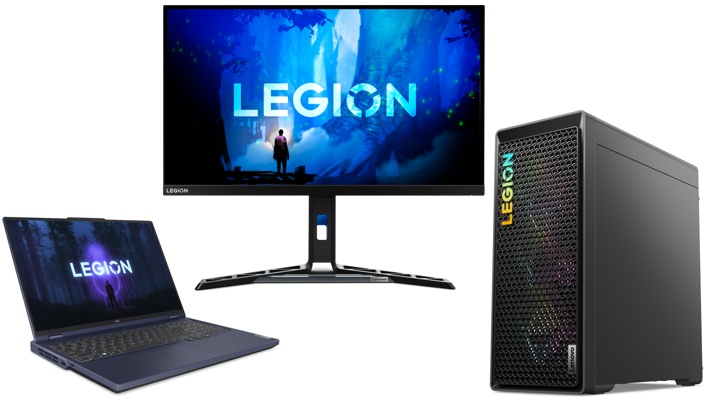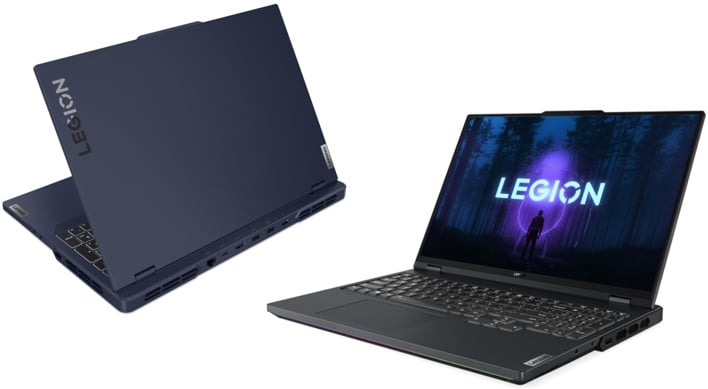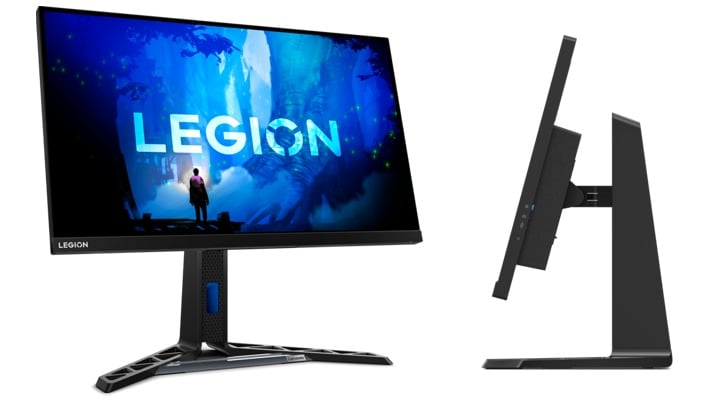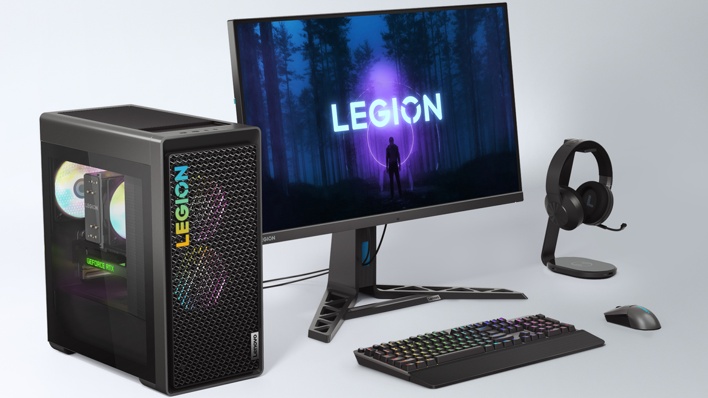Lenovo Equips Legion Of Gaming Laptops And PCs With A Vicious Raptor Lake And Ryzen Arsenal

Last month, Lenovo preempted CES 2023 by unveiling an assortment of new IdeaPad and ThinkPad devices. However, these early announcements didn’t reveal Lenovo’s full lineup of new and updated offerings. Now that CES is here, Lenovo has even more new laptops, monitors, and PCs to show off. In this post, we’re going to take a look at the new products in the company’s Legion gaming series, but first we should mention that we’ve teamed up with Lenovo to offer HotHardware readers a change to win some tech gear in a CES 2023 giveaway. Before reading the rest of this post, go check out our announcement of the giveaway and enter to win one of four prize packs.
Now that you’re back from entering the giveaway, we’ll start with Lenovo’s unveiling of the Legion Pro laptops. The big news here is that these laptops feature new custom silicon in the form of the Lenovo LA AI chip. According to the company, this chip powers the Lenovo AI Engine+, which “deploys a software machine learning algorithm to optimally tune system performance.” Lenovo is targeting gamers with this hardware and software integration by monitoring in-game FPS through Lenovo Vantage and dynamically adjusting various system parameters to boost performance.
Lenovo actually has two variants of this AI chip, the LA1 and LA2-Q, and they serve as a distinguishing factor between the company’s Legion Pro 5/5i and Legion Pro 7/7i laptops. The Pro 5 and 5i feature the LA1, while the Legion Pro 7 and 7i bear the LA2-Q. The Pro 7 and 7i are slightly bigger and heavier to accommodate this presumably more potent chip, as well as a bigger battery to power it. The other major difference between the two comes down to buyers’ choice of processors.
In the case of the Intel-based models, the Pro 7i will be available with an Intel Core i9-13900HX or Core i7-13700HX, while Pro 5i buyers will get the additional option of a Core i7-13500HX. As for the AMD-based models, the differences are more clear-cut. The Pro 7 will come exclusively with an AMD Ryzen 9 7945HX, while buyers will be able to equip the Pro 5 with a Ryzen 9 7845HX, a Ryzen 7 7745HX, or a Ryzen 5 7645HX. However, regardless of buyers’ choice in CPU, all models will come with next gen NVIDIA GeForce graphics. All models will also come with up to two 1TB PCIe SSDs and 32GB of DDR5 RAM, though the memory is overclocked in the case of the Pro 7 and 7i from 5600Mhz to 6000Mhz.
Lenovo indicates that the Legion Pro 7i will first be available sometime in March at a starting price of $1999.99. However, the Pro 7i’s AMD-based brother, the Pro 7, won’t be available in North America. That said, AMD-fans will be able to get their hands on the Pro 5. Lenovo expects both the Pro 5 and 5i to be available in April with starting price tags of $1459.99 and $1479.99, respectively.
Lenovo actually has two variants of this AI chip, the LA1 and LA2-Q, and they serve as a distinguishing factor between the company’s Legion Pro 5/5i and Legion Pro 7/7i laptops. The Pro 5 and 5i feature the LA1, while the Legion Pro 7 and 7i bear the LA2-Q. The Pro 7 and 7i are slightly bigger and heavier to accommodate this presumably more potent chip, as well as a bigger battery to power it. The other major difference between the two comes down to buyers’ choice of processors.
In the case of the Intel-based models, the Pro 7i will be available with an Intel Core i9-13900HX or Core i7-13700HX, while Pro 5i buyers will get the additional option of a Core i7-13500HX. As for the AMD-based models, the differences are more clear-cut. The Pro 7 will come exclusively with an AMD Ryzen 9 7945HX, while buyers will be able to equip the Pro 5 with a Ryzen 9 7845HX, a Ryzen 7 7745HX, or a Ryzen 5 7645HX. However, regardless of buyers’ choice in CPU, all models will come with next gen NVIDIA GeForce graphics. All models will also come with up to two 1TB PCIe SSDs and 32GB of DDR5 RAM, though the memory is overclocked in the case of the Pro 7 and 7i from 5600Mhz to 6000Mhz.
Lenovo indicates that the Legion Pro 7i will first be available sometime in March at a starting price of $1999.99. However, the Pro 7i’s AMD-based brother, the Pro 7, won’t be available in North America. That said, AMD-fans will be able to get their hands on the Pro 5. Lenovo expects both the Pro 5 and 5i to be available in April with starting price tags of $1459.99 and $1479.99, respectively.
Lenovo also announced new gaming-goodness for stationary set ups, beginning with two high refresh rate monitors. The Y27f-30 and Y27qf-30 share the same chassis and physical dimensions, both bearing 27-inch panels. However, the “q” in Y27qf-30 hints at the monitor’s QHD (2560x1440) display in contrast to the FHD (1920x1080) display of the Y27f-30. Both displays share a base refresh rate of 240Hz, but the lower resolution display supports overclocking up to 280Hz, while the same process can raise the QHD display to only 250Hz.
These refresh rates aren’t near as high as the 500Hz and 540Hz supported by monitors just announced by Alienware and ASUS, but 240Hz should be plenty for the vast majority of gamers. Beyond refresh rate, both Lenovo Legion monitors 0.5ms of response time with Moving Picture Response Time (MPRT) enabled, though this feature can induce flicker and will disable adaptive sync in the form of AMD FreeSync. However, even without MPRT, these displays can still reach 1ms of response time. They are also both VESA DisplayHDR 400 certified. Lenovo also highlights the wide viewing angles of the IPS panels, as well as Natural Low Blue Light technology.
Both monitors will be available for purchase in May, with the lower resolution Y27f-30 currently priced at $399 and the higher resolution Y27qf-30 priced at $599.
These refresh rates aren’t near as high as the 500Hz and 540Hz supported by monitors just announced by Alienware and ASUS, but 240Hz should be plenty for the vast majority of gamers. Beyond refresh rate, both Lenovo Legion monitors 0.5ms of response time with Moving Picture Response Time (MPRT) enabled, though this feature can induce flicker and will disable adaptive sync in the form of AMD FreeSync. However, even without MPRT, these displays can still reach 1ms of response time. They are also both VESA DisplayHDR 400 certified. Lenovo also highlights the wide viewing angles of the IPS panels, as well as Natural Low Blue Light technology.
Both monitors will be available for purchase in May, with the lower resolution Y27f-30 currently priced at $399 and the higher resolution Y27qf-30 priced at $599.
Gamers may also be looking for a desktop PC to pair with Lenovo’s new Legion monitors, so the company has introduced the Legion Tower 7i, 5i, and 5. The taller Tower 7i offers a range of high-end 13th Gen Intel Core CPUs and next gen NVIDIA GeForce RTX GPUs. Buyers will also be able to load this system with up to 64GB of 5600Mhz DDR5 RAM and up to three 2TB M.2 PCIe NVMe SSDs. Six fans with ARGB lighting should keep this system cool and quiet no matter the chosen specs, but buyers can go the extra mile and add a liquid cooling system.
The Tower 5i and 5 offer scaled-back options at lower price points. Both desktops will have multiple available CPU options, with the 5i topping out at the Intel Core i9-13900F and the 5 topping out at the AMD Ryzen 9 7900. Buyers will be able to choose from a range of next gen NVIDIA GeForce GPUs in both cases, but the AMD-based system will also be available with Radeon RX 7000 series graphics. As for memory and storage, the top listed options for both systems are 32GB of 5600Mhz DDR5 RAM and two 1TB M.2 PCIe NVMe SSDs. These smaller systems lose a fan and the optional liquid cooling system, but the five ARGB fans should still be more than sufficient to keep the systems cool without much noise.
Both Intel-based desktop PCs are set to be available in April, with the Tower 7i starting at $2479.99 and the Tower 5i starting at $1199.99. Following behind the other two, the AMD-based Tower 5 should become available for purchase in May beginning at $1299.99.
The Tower 5i and 5 offer scaled-back options at lower price points. Both desktops will have multiple available CPU options, with the 5i topping out at the Intel Core i9-13900F and the 5 topping out at the AMD Ryzen 9 7900. Buyers will be able to choose from a range of next gen NVIDIA GeForce GPUs in both cases, but the AMD-based system will also be available with Radeon RX 7000 series graphics. As for memory and storage, the top listed options for both systems are 32GB of 5600Mhz DDR5 RAM and two 1TB M.2 PCIe NVMe SSDs. These smaller systems lose a fan and the optional liquid cooling system, but the five ARGB fans should still be more than sufficient to keep the systems cool without much noise.
Both Intel-based desktop PCs are set to be available in April, with the Tower 7i starting at $2479.99 and the Tower 5i starting at $1199.99. Following behind the other two, the AMD-based Tower 5 should become available for purchase in May beginning at $1299.99.




